
Dharampur State was a princely state in India during the time of the British Raj. Its last ruler acceded to the Union of India 10 June 1948.

Rewa Kantha was a political agency of British India, managing the relations of the British government's Bombay Presidency with a collection of princely states. It stretched for about 150 miles between the plain of Gujarat and the hills of Malwa, from the Tapti River to the Mahi River crossing the Rewa River, from which it takes its name.
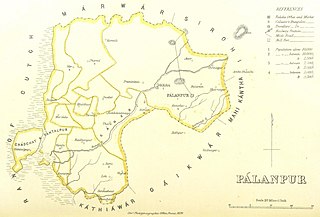
Palanpur Agency, also spelled Pahlunpore Agency, was a political agency or collection of princely states in British India, within the Gujarat Division of Bombay Presidency. In 1933, the native states of the Mahi Kantha Agency, except for Danta, were included in the Western India States Agency. The agency, headquartered at Palanpur, oversaw some 17 princely states and estates in the area, encompassing an area of 6393 square miles (16,558 km2) and a population, in 1901, of 467,271.

Rajkot State was one of the princely states of India during the period of British rule. It was a 9-gun salute state belonging to the Kathiawar Agency of the Bombay Presidency. Its capital was in Rajkot, located in the historical Halar region of Kathiawar on the banks of the Aji River. Nowadays, Rajkot is the fourth largest city of Gujarat state.

Baroda State was kingdom within the Maratha Confederacy and later princely state in present-day Gujarat, ruled by the Gaekwad dynasty from its formation in 1721 until its accession to the newly formed Dominion of India in 1949. With the city of Baroda (Vadodara) as its capital, during the British Raj its relations with the British were managed by the Baroda Residency. The revenue of the state in 1901 was Rs. 13,661,000. Baroda formally acceded to the Dominion of India, on 1 May 1949, before which an interim government was formed in the state.

Vav is a town and the headquarters of Vav Taluka in Banaskantha district in Gujarat state of India. Vav is the largest taluka of the district.

Akkalkot State during the British Raj, was a Maratha princely state ruled by the Bhonsle dynasty. The non-salute state came under the Deccan States Agency and was bordered by Hyderabad State and the Bombay Presidency.

Jambughoda is a Wildlife Sanctuary situated in Jambughoda Tehsil, in the South-Central part of Gujarat, and the Khathiar-Gir dry deciduous forests' ecoregion in India. It is located 70 km from Vadodara and 20 km from prominent tourist places such as Pawagadh and Champaner.
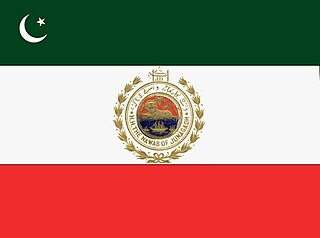
Junagarh or Junagadh was a princely state in Gujarat ruled by the Muslim Babi dynasty in India, which acceded to the Dominion of Pakistan after the Partition of British India. Subsequently, the Union of India annexed Junagadh in 1948, legitimized through a plebiscite held the same year.

Dewas Senior was established by Tukoji Rao I Pawar during the Maratha conquest of Central India. It was a 15 Gun Salute Maratha princely state. On 12 December 1818 it became a British protectorate.

Jafarabad, or Jafrabad State, was a tributary princely state in India during the British Raj. It was located in the Kathiawar Peninsula on the Gujarat coast. The state had formerly been part of the Baroda Agency and later of the Kathiawar Agency of the Bombay Presidency.
Jambughoda is a village and Tehsil in Panchmahal district in the Indian state of Gujarat. The village has a population of 2,731, while the overall tehsil has a population of 42,476.
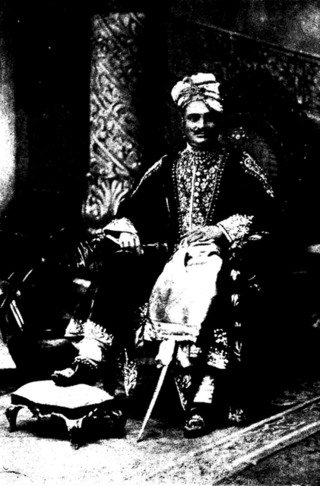
Santrampur State is a former state located in the present-day state of Gujarat, India. It covered an area of approximately 1,367 km2 (528 sq mi) and was bounded on the north by the dominions of Dungarpur and Banswara in Rajputana. On the east was the sub division of Jhalod in the Panch Mahals. On the south it touched the small state of Sanjeli while on the west it was bounded by the State of Lunavada.The State enjoyed a hereditary salute of 9 gun and 11 gun local salute. The rulers of state claim descent from the Mahipavat branch of the Malwa dynasty.

Morvi State, also spelled as Morvee State or Morbi State, was a princely salute state in the historical Halar prant (district) of Kathiawar during the British Raj.

Surgana State was a princely state of the Bombay Presidency during the era of the British Raj. It was the only state belonging to the Nasik Agency. Its capital was Surgana in Nashik District of present-day Maharashtra. It was ruled by Pawar dynasty of Marathas.

Baroda and Gujarat States Agency was a political agency of British India, managing the relations of the British government of the Bombay Presidency with a collection of princely states.

Lunavada State, also known as Lunawada State, was a princely state in India during the time of the British Raj. Its last ruler acceded to the Union of India on 10 June 1948.
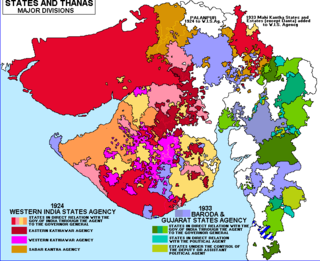
The Baroda, Western India and Gujarat States Agency was an agency of the Indian Empire, managing the relations of the Provincial Government of the Bombay Presidency with a collection of princely states.
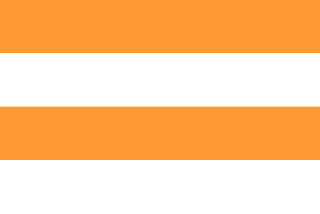
The Baria State, also known as Bariya State, was one of the princely states of India during the period of the British Raj. It was under the Rewa Kantha Agency of the Bombay Presidency and had its capital in Devgadh Baria town of present-day Dahod district in Gujarat state. The Baria State was ruled by Koli chieftains of Baria clan (Gotra) of Gujarat, who later claimed to be kshatriya.

Radhanpur State was a kingdom and later princely state in India during the British Raj. Its rulers belonged to a family of Babi House, the state was once a polity within the Mughal Empire. The last ruling Nawab of Radhanpur, Nawab Murtaza Khan, signed the instrument of accession to the Indian Union on 10 June 1948.





















